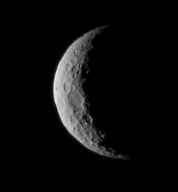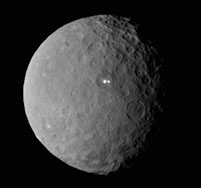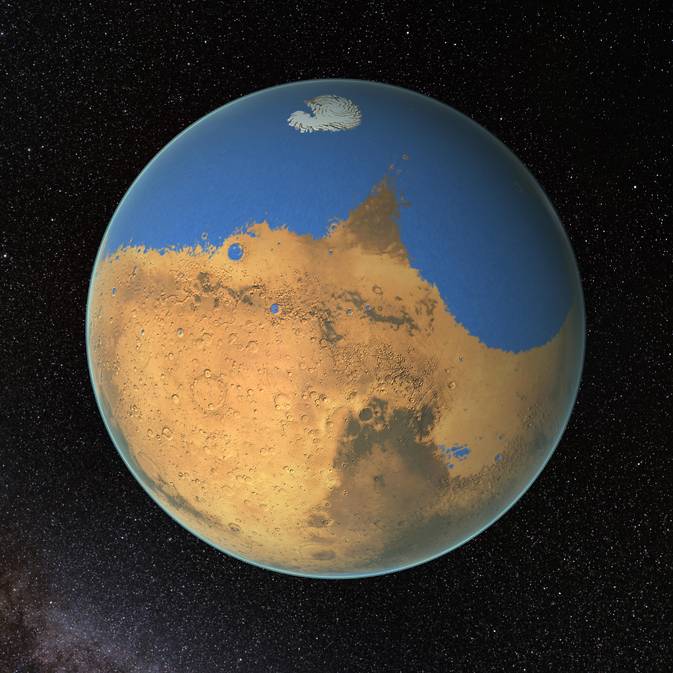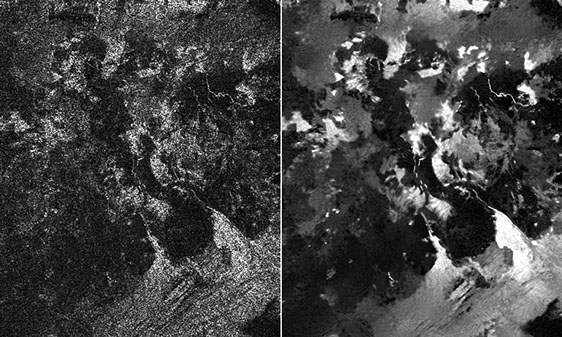

March 2015
Ceres Orbit Achived
NASA's Dawn spacecraft entered orbit around the dwarf planet Ceres on Friday, March 6th at 4:39 AM PST. Dawn becomes the first spacecraft to orbit a dwarf planet. Dawn also became the first spacecraft to orbit two extraterrestrial objects, having orbited the asteroid Vesta in 2011 and 2012.
Dawn entered orbit at an altitude of 38,000 miles (61,000 km) above the dwarf planet and will move closer to the planet over the next month. Currently Dawn is on the dark side of Ceres but by mid-April will emerge to the sunlit side.
Dawn has just arrived and already has a huge mystery to figure out. Two bright white spots are seen in a crater on Ceres. Speculation is that a meteor may have hit the area recently and exposed ice below the surface.
Ceres is located between Mars and Jupiter and was discovered in 1801. At one time it was thought to be a planet but it was decided it was an asteroid. With the new category of dwarf planet, Ceres was one of the first objects put into that classification.
Dawn's primary mission will run for about 18 months through July of 2016.


Image Credit: NASA/JPL-Caltech/UCLA/MPS/DLR/IDA
Left: Ceres when Dawn entered orbit
Right: Two white spots seen in a crater on Ceres
The Missing Brown Dwarf
V471 Tauri is a binary star system in the Hyades cluster in the constellation Taurus. It is estimated to be around 600 million years olds and 163 light-years from Earth.
At one time, the larger of the two stars expanded to become a red giant shedding its gases. These gases eventually disperse as the red giant shrinks down to a white dwarf. The white dwarf and the normal star now move close together. This is common in the life of binary stars where the two stars are about the same size as our sun. They are known as post-common-envelope binaries.
The two stars in V471 Tauri orbit each other once every 12 hours. Twice per orbit, as observed from Earth, one star passes in front of the other. At this time, as one star eclipses the other, instruments on Earth can measure the change in brightness. Scientists have been using the ULTRACAM system on ESO's New Technology Telescope in Chile to measure V471 Tauri with an accuracy of better than two seconds. They discovered that the times varied from pass to pass. This was explained by the theorized existence of a brown dwarf. A brown dwarf is a star that failed to ignite.
To find the brown dwarf, scientists used the SPHERE instrument on the Very Large Telescope. SPHERE is able to image a brown dwarf that is 70,000 times fainter and only 0.26 arcseconds from a star. The brown dwarf theorized to be around V471 Tauri would be much larger than that. But SPHERE found nothing. No brown dwarf. No companion star. Nothing.
The missing brown dwarf means that the current explanation of the the variable brightness is wrong. Not only does this invalidate the theory at V471 Tauri, but puts in doubt like-theories at other stars.
New theories are being proposed. It may be possible that magnetic field variations in the larger star is the cause. This effect is called the Applegate mechanism. As the magnetic field produces changes in the shape of the star, the apparent brightness of the star will change as seen from Earth.
Possible Intermediate-mass Black Hole
NGC2276-3c is a newly discovered cosmic object. It is located in the arm of the spiral galaxy NGC 2276, located 100 million light years away. Astronomers think it could be an intermediate-mass black hole (IMBH).
Astronomers have gathered a lot of information about supermassive black holes (millions to billions times the mass of the sun) and small black holes (five to thirty times the mass of the sun). But they have not been able to find middle sized black holes (a few hundred to a few thousand times the mass of the sun) although they have been theorized. They may even be the seeds from which the supermassive black holes form.
A new study used the Chandra X-ray space telescope and the European Very Long Baseline Interferometry (VLBI) Network to study NGC2276-3c. NGC2276-3c had been known as a ultraluminous X-ray source. Astronomers used both instruments at the same time to take their measurements. They discovered a mass of about 50,000 times that of the sun. That puts it in the range for a IMBH.
It was discovered that NGC2276-3c has a powerful radio jet that extends up to 2000 light-years. In the first 1000 light-years of the jet there was observed no young stars. This suggests the IMBH could have cleared out that area of space and suppressed the formation of new stars.
Another question raised is where did this IMBH come from? It is located in the arm of the spiral galaxy NGC 2276. Was it formed in the galaxy or did it come from the center of a dwarf galaxy that collided with it and merged with it in the past?
Further studies of NGC2276-3c can help provide insight into the origins of the supermassive black holes and their effects on the early universe. Finding an IMBH can now finally put the missing part of the black hole family tree together.

Galaxy NGC 2276
Image Credit: X-ray: NASA/CXC/SAO/M.Mezcua et al & NASA/CXC/INAF/A.Wolter
Upcoming Launches
Date: March 12
Launch Vehicle: Atlas V 421
Launch Site: Cape Canaveral Air Force Station, Florida
Description: Launch of Megnetospheric Multiscale (MMS) to study how magnetic fields around Earth connect and disconnect, explosively releasing energy via a process known as magnetic reconnection.
Date: March 27
Launch Vehicle: Soyuz
Launch Site: Baikonur Cosmodrome, Kazakhstan
Description: Launch of Scott Kelly, Mikhail Kornienko and Gennady Padalka to the International Space Station.
Supermassive Black Hole Winds
NASA's Nuclear Spectroscopic Telescope Array (NuSTAR) and ESA's XMM-Newton telescope have been measuring the winds blown out by supermassive black holes. NuSTAR observes the high-energy portion of the the X-ray light spectrum and XMM-Newton observes the low-energy portion.
As a black hole feeds on matter, the process produces strong winds. These winds are so strong that it is thought that regulate the growth of galaxies by inhibiting new star formation. Up until now, the speed, shape and size of the winds was only speculated. NuSTAR and XMM-Newton have now measured these winds at the black hole PDS 456.
PDS 456 is a supermassive black hole with a very bright quasar located over 2 billion light-years away. The X-ray emitting winds are traveling at about a third of the speed of light and carry more energy every second than is emitted by more than a trillion suns. These winds are powerful enough to drive out all the gas in that area of the galaxy. Without the gases, no new stars can form.
Astronomers think that supermassive black holes and their home galaxies evolve together. As the black hole grows, more winds blow out stopping new star formation. In the early universe, around 10 billion years ago, supermassive black holes were very active and this latest data supports the theory that they helped shape the galaxies.
An Ocean on Mars
At one time Mars had an ocean. A large ocean covering half of its northern hemisphere. An ocean larger than the Atlantic ocean on Earth. An ocean over a mile (1.6 km) deep. These are the new results from a study using ESO's Very Large Telescope in Chile and the Keck Observatory and NASA Infrared Telescope Facility in Hawaii.
Using both facilities, scientists were able to distinguish two chemical signatures of two slightly different forms of water in Mars' atmosphere, H2O and HDO. H2O is common water while HDO is a variation in which one hydrogen is replaced with a heavier form called deuterium.
By comparing the levels of H2O and HDO in the atmosphere today and the levels in Martian meteorites from 4.5 billion years ago, scientists determined how much water escaped into space over time. As HDO is heavier, it is less easily lost by evaporation. So the greater the water loss, the greater the ratio of HDO to H2O in the water remains.
The scientists mapped the Martian atmosphere several time over the span of three Martian years. Even though Mars is a desert, there are seasonal changes and microclimates. By looking at the polar areas the scientists could measure the water variations. The polar areas are thought to document the evolution of Mars' water during the wet Noachian period which ended about 3.7 billion years ago, to today.
The results show that Mars must have lost a volume of water 6.5 times larger than the present ice caps. Since the northern hemisphere is a low laying region, it seems likely that the water on Mars those billions of years ago would have occupied that area.

Artist concept of how ocean on Mars would have looked.
Image Credit: NASA's Goddard Space Flight Center
Titan Images Despeckled
A new algorithm has been developed that can eliminate the electronic noise visible in photos taken of Saturn's moon Titan by the Cassini spacecraft. This technique, called despeckling, removes the "noise" and allows scientists to see the surface features without the grainy appearance. The result is a clearer image showing more detail without showing things that are not really there. It is very important that the despeckling only takes out electronic noise and not eliminate or put in features that are not there.
So far, only selected photos are getting the treatment due to the complexity of the technique. In the future, new 3-D maps of the surface can be created with improved clarity and detail.

Above Photo: Original photos on top and despeckled photos on bottom
Lower Photo: Original photo left and despeckled photo right
Image credit: NASA/JPL-CalTech/ASI

© 2014-2016 Ted Cook Productions LLC. - All Rights Reserved

